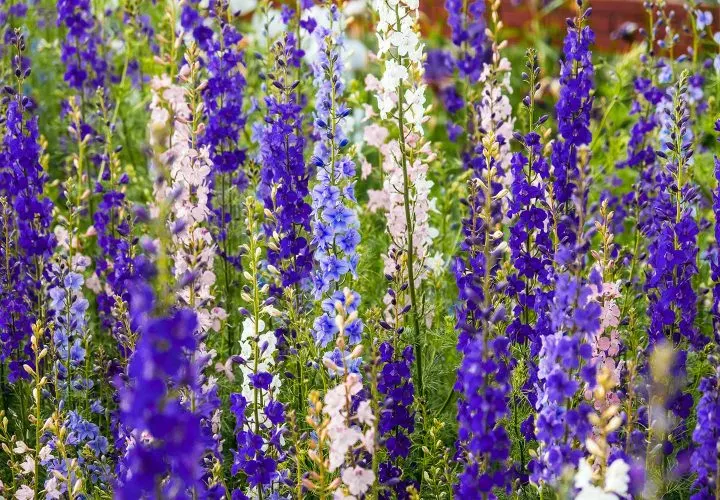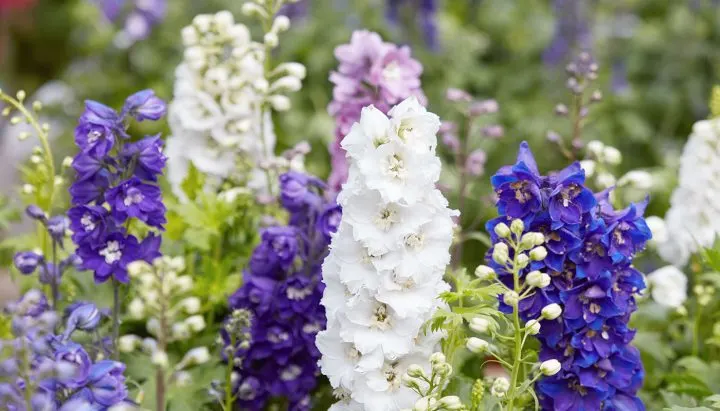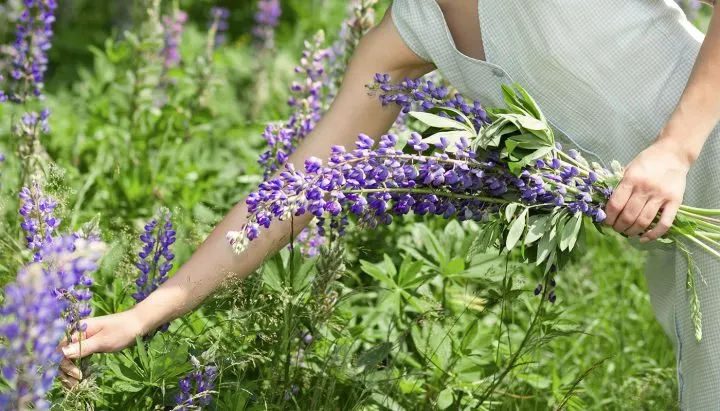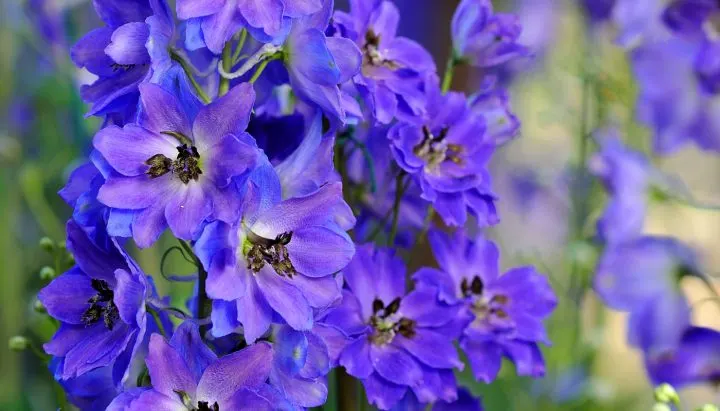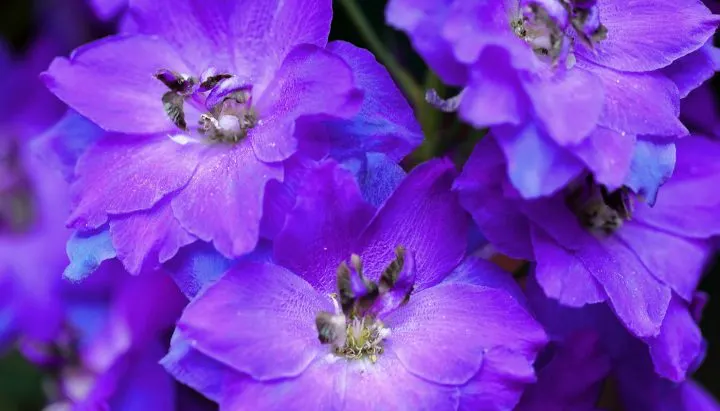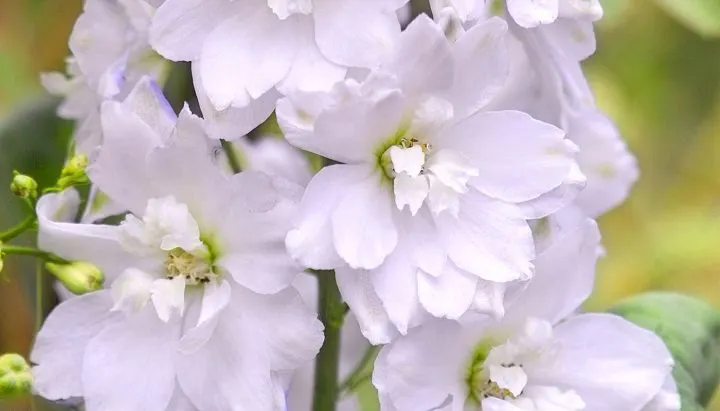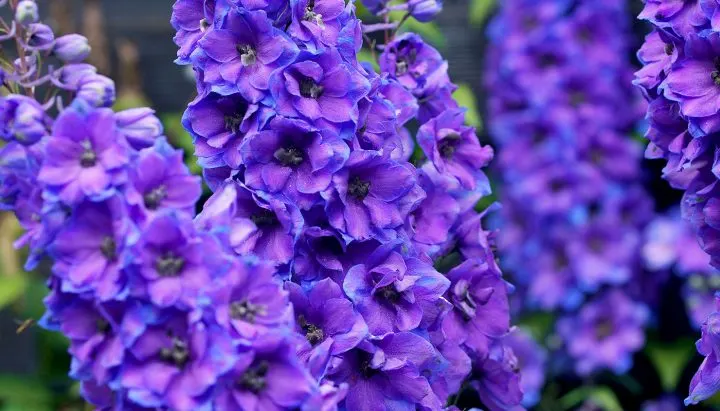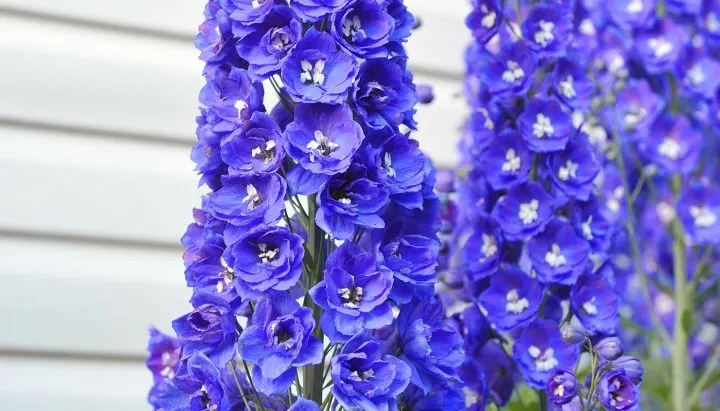August 17, 2021
Delphinium Care Guide: Instructions + Tips
The delphinium is a type of perennial plant known for its long stem and vibrant blue, purple, pink or white flowers. Although these plants make gorgeous additions to any garden, they can be tricky to grow — that’s why learning proper delphinium care is key.
From maintaining gentle sunlight to avoiding potential poisoning, there’s a lot to keep in mind when growing your delphiniums. To make it easier, we created the ultimate delphinium care guide so you can follow the simple tips below and watch your delphiniums thrive.
Delphinium Overview
The delphinium belongs to the Ranunculaceae family native to the Northern Hemisphere. In total, delphiniums include over 300 species. However, when people admire the height of the delphinium plant, they’re likely referring to the elatum (tall) variety.
These towering plants have been adored for centuries. In ancient times, the Greeks believed the closed flower buds looked like a dolphin’s nose. As a result, they named the plant after the word “delphis,” which means “dolphin” in Greek. For the Tudors, the name “larkspur” seemed more fitting, since they thought the nectar resembled a lark’s claw. Today, both delphinium meanings and names are used interchangeably.
Due to the delphinium’s bright colors, Native Americans and Europeans used the flower to make dye. The plant also has the ability to cure scorpion stings and ward off certain parasites. Finally, the delphinium is the July birth flower, making it the perfect gift for a July baby.
How To Care for Delphiniums
When it comes to delphinium care, knowing what your plant needs is critical for keeping it healthy during the blooming season. Most delphiniums prefer gentle sunlight, mild temperatures and moist soil. Gardeners should also keep in mind that delphiniums can be toxic and catch diseases. Here’s a more detailed breakdown of proper delphinium plant care:
Planting
The best time to plant delphiniums is in the spring. Delphiniums need a lot of drainage, so it’s a good idea to use organic matter and compost in their soil. These additional materials can help amend the soil and create a well-drained garden bed.
Create a hole in the soil that’s two times the diameter of the original container, and plant your delphinium so the top of its root ball is at the same level as the ground and the plants are 1 to 3 inches apart. Backfill the hole, pat down the soil and water your plant.
Staking
To support tall delphiniums, you’ll need to add stakes early in the growth process. Once they reach about 1 foot tall, add grow-through supports, cages or three bamboo stakes around each plant and use string to hold them up at the base. With the right staking, your delphiniums can grow upright and potentially survive wind and storms. As they grow, be sure to thin out shoots for maximum air circulation.
Sunlight
Delphiniums need around six to eight hours of sun every day to look their best, and gentle morning or afternoon sunlight is optimal. If you live somewhere warmer, make sure your delphiniums get enough shade from the hot afternoon sun.
Water
To give your delphiniums proper hydration, pour 1 inch of water at the base of the plant and avoid getting the leaves wet. But be careful — if there’s too much moisture, your delphiniums could rot.
If they already get at least 1 inch of water from the rain, avoid overwatering them during that time. However, you should also make sure the soil never gets too dry during hotter seasons.
Soil
In addition to watering, you should take other measures to keep your delphiniums’ soil in good condition. Delphiniums need fertilized, moist soil, so you should use a balanced liquid fertilizer every two or three weeks. Also, be sure to add compost to the soil during the spring and mulch before winter to lock in moisture.
Temperature
Delphiniums are at their best with temperatures between around 60 and 70 degrees Fahrenheit. To help them survive harsh winters, you may want to add mulch for a protective layer against the elements. During hotter months, make sure they’re getting enough shade throughout the day.
Pruning
When you notice your blooms beginning to fall off during the blooming season, be sure to cut those flower spikes. That way, your delphiniums can keep blooming during the summer. If winter temperatures begin to kill your garden vegetation, cut off all the stems and prune them again in the spring so the plants can grow back in the summertime.
Toxicity
Although human poisoning from the delphinium is rare, the plant is still toxic for other mammals. For example, some cattle in the Western U.S. have been poisoned by the plant. Before growing your own delphiniums, be mindful of the animals that visit your garden. If you have furry friends at home, you might want to opt for pet-safe plants instead.
Pests & Problems
Pests: The most common pests eating your delphiniums are slugs and snails, which usually do their damage at night. If you find holes in the leaves and stems, you may have a critter problem on your hands. To keep these pests away from your plants, try removing them yourself or using slug and snail bait.
Problems: Delphiniums can become infected with a variety of diseases including aster yellows, powdery mildew, diaporthe blight and rotting of the root, crown or stem. Keep an eye out for any discoloration, unpleasant odor and deformation. In most cases, you can remedy the disease by removing the affected areas.
Repotting & Propagation
Repotting: The key to repotting or transplanting delphiniums is preserving as much root as possible. To do so, gently dig around and lift the roots. Once you transfer your plant, add a few inches of soil, fertilizer, water and stakes for taller plants. If you’re using a container, make sure it has drain holes.
Propagation: For optimal propagation, it’s best to take cuttings from the base of the plant in springtime. Simply cut new shoots below the leaf node that appear right under the soil and store them in a plastic bag. Then, place your cuttings in a small vase of clean water or a pot covered in compost, perlite soil and a plastic bag. Be sure to keep your plants hydrated with mist. The best spots for propagating delphiniums are window sills and greenhouses.
Types of Delphiniums
If you look closely, you’ll notice that there are hundreds of varieties of delphiniums out there. The most common differences include maintenance requirements, color and bloom shape. Take a look through some of the types to see which one you might want to grow.
1. Black Knight
This delphinium variety has dark purple petals with black eyes at the center. It usually grows to be around 6 feet tall and requires the basic delphinium care outlined above. Its vibrant color is also the perfect addition to purple bouquets.
2. Blue Lace
With a light pink middle and pale blue lace bordering the petals, this type of delphinium adds a soft, pastel touch to your space. When it comes to maintenance, this variety can do just fine in partial or direct sunlight. Hummingbirds might even pay a visit to this 6-foot plant.
3. Pagan Purple
Bright purple petals make this 6-foot variety a striking addition to your garden. With enough drainage and full or partial sunlight, these plants may also be able to withstand more extreme conditions like heat, humidity and cold. Can’t get enough purple? Take a look at other purple flowers to add to your yard.
4. Galahad
Standing at 4 to 6 feet tall, this variety has white blooms that are sure to draw attention. For proper care, make sure your Galahad receives direct sunlight and has soil with enough moisture and drainage. This variety is just one of the many white flowers for your garden.
5. Faust
The bright blue blooms on this variety are sure to catch your eye. Not only does this plant add a pop of color to your yard, but it’s easy to maintain with direct sunlight and well-drained soil. You might also notice a lot of bees coming to visit.
6. Magic Fountain White
For smaller spaces, this 2-to-3-foot variety makes the perfect fit. Since they’re shorter, you won’t need to stake them. This type also does well in direct or partial sunlight, and hummingbirds and butterflies tend to be frequent visitors. If you like the look of this flower, check out the hydrangea care guide to grow similar blooms.
7. Princess Caroline
Another short variety is the Princess Caroline, which stands at around 2 or 3 feet tall. Its pink and red coloring adds a bright flare to your home or yard. Like the Magic Fountain White, this type can handle the sun and attracts hummingbirds and butterflies.
8. Delfix Blue
This variety is even shorter, reaching just 12 to 15 inches tall. Its blooms are a rich blue color with lacing in shades of purple and white, and its bushy foliage forms a beautiful green bed. The Delfix Blue can also take the heat, as it grows well in direct sunlight.
9. Bruce
With its vivid purple flowers and 6-foot height, the Bruce variety is a standout addition to any yard. It does especially well in full sunlight and makes a popular destination for nearby bees.
10. Royal Aspirations
As the name suggests, Royal Aspirations grow in a vibrant royal blue color and stand at up to 5 feet tall. This variety can handle full or partial sunlight and, like many other delphiniums, is adored by hummingbirds and butterflies. For more shades of blue, take a look at the other blue flowers you can grow.
Delphinium Care FAQs
Still unsure about proper delphinium care? Read through our answers to the most commonly asked questions about delphiniums.
Do delphiniums like sun or shade?
In general, delphiniums need six to eight hours of sunlight per day. Although some varieties can handle full sun, most are at their best when exposed to mild or partial sunlight in the morning and afternoon. However, make sure to provide the roots with enough shade and protection from harsh winds, as they can cause delphiniums to grow sideways or fall down.
Do delphiniums come back every year?
Delphiniums are summer flowers that typically bloom toward the beginning of the season and again at the start of fall. Although their season is relatively short, delphiniums are perennials, which means they return annually with proper care. If you cut them after they blossom and provide them with enough water and fertilizer, your delphiniums should come back the following year.
How do you keep delphiniums blooming?
To keep your delphiniums blooming, you’ll need to cut the main stalk once the flower petals start to fall off. Then, fertilize the soil and water the remaining side shoots. Pruning your delphiniums can help them bloom all summer long, and it’ll also give you some lovely cut flowers for your home.
How do you keep delphiniums over winter?
For proper delphinium winter care, it’s critical to place organic mulch on top of the soil once the season changes. Some materials you can use include chopped leaves, dry grass, straw or bark. This mulch can help keep the soil moist and avoid damage caused by colder temperatures.
Delphinium Bouquet Care Tips
Since pruning is an important part of delphinium plant care, you might want to make use of all the gorgeous cut flowers. One way to do so is by creating a floral arrangement for your home. You can either use the delphiniums as filler flowers or create a summer bouquet full of them. Delphiniums can last one to two weeks in a vase with proper care, so here are some tips to keep your bouquet at its best:
Trim the Stems
Some delphiniums can grow as tall as 6 feet, so you’ll need to cut the stems before arranging your bouquet. If you have a vase handy, trim the plant so the stems fit inside the particular vase size. That way, the blooms have all the attention. In addition, since delphiniums have hollow stems that may dry out quickly, you can add water inside each stem and seal the bottoms with cotton balls.
Arrange Delphiniums in a Vase
Next, you’ll need to pour fresh, room temperature water into two-thirds of your vase. To help your water nourish your plants and fight bacteria, consider adding flower food or two tablespoons of white vinegar and three tablespoons of sugar per quart-sized vase. Then, put each stem into your vase and adjust the placement to your liking. For tips on perfecting your display, read our guide to arranging flowers.
Keep Flowers Cool
To ensure that your delphiniums last longer in their vase, place them in an area of your home that has a lot of shade. In addition, keep fruit bowls away from your bouquet — when fruits ripen, they emit ethylene gas that can damage delphiniums.
Replace Water
To keep your flowers fresh, you’ll need to replace the water every other day. First, gently remove the flowers and use warm water to rinse the vase. Then, refill the vase with clean water and add in your bouquet again.
Once you know all the necessary tips for proper delphinium care, you’re ready to grow some of your own. Check out our selection of larkspur flowers and choose the variety you like best.
Want to preserve your delphiniums even longer? Learn how to dry flowers so you can admire your floral display for months.

